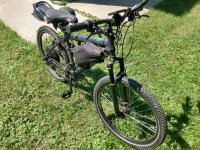Zarathustra1984
100 µW
- Joined
- Jul 3, 2020
- Messages
- 9
Hello everyone. Long-time lurker and first time poster here. I appreciate the wealth of knowledge you all have given and it's helped make my dream bike (cheapo) come true. This is my first build after a period of about 10 years not owning a bike and want to give thanks.
The lowdown is that it has a 500W hub motor, KT48ZWSRKT-SJT02L, and 50A BMS 10AH battery and I'm getting intermittent LCD-3 shutoffs under load when I apply the throttle - even gently. It accelerates as fast as a car and I set the speed limit to 30 mph to stay within the law as it will do just that. The LCD-3 shows ~800 watts being put out when under full throttle load and the Voltage drops to ~43-44 and slowly climbs as speed increases and thus load decreases. I did not think to see the Voltage when the issue occurred, only now.
The first night I took it out, I went about 15 miles stop/go driving in the city with mostly full-throttle rips and speed limited; had a great time. Last night, mostly the same, but didn't drive it as hard, and around the similar mileage, the system shut down when applying throttle from a stop - it made it about 10 feet and the LCD-3 shut off. I unplugged and plugged back in the battery and I was able to use P.A.S. mode to limp it home. Any time the throttle isn't babied (like 1/10th of full twist) and it eased up to speed, it would immediately shut off the system. P.A.S. #5 will cause a shutdown. Once, I was able to get the LCD-3 to flash the battery meter being empty and then a slow fading shutdown - this on at least 75% battery. I gave it a full charge overnight and the same thing this morning for ~10 miles. Now, here the kicker: I had it on the charger for a while just now and decided to make a quick run to the store and it read ~52v and was able to apply full throttle again - even from a dead stop as if the issue went away. Note, this morning the system was completely cooled and just now it was plenty warm. I'll add that the "Regenerative Braking" only kicks in for about 1 sec when it's on a stand and also that the battery meter gauge in the upper left-hand of the screen doesn't seem very accurate.
I'm really at a loss here as to what is happening and hope ya'll could give some insight. She's not much to look at, but here's a few pics of an uncompleted build.
Full-size images:
https://ibb.co/dW9YXHN
https://ibb.co/wcF0Dw8
https://ibb.co/xGWF7tR
The lowdown is that it has a 500W hub motor, KT48ZWSRKT-SJT02L, and 50A BMS 10AH battery and I'm getting intermittent LCD-3 shutoffs under load when I apply the throttle - even gently. It accelerates as fast as a car and I set the speed limit to 30 mph to stay within the law as it will do just that. The LCD-3 shows ~800 watts being put out when under full throttle load and the Voltage drops to ~43-44 and slowly climbs as speed increases and thus load decreases. I did not think to see the Voltage when the issue occurred, only now.
The first night I took it out, I went about 15 miles stop/go driving in the city with mostly full-throttle rips and speed limited; had a great time. Last night, mostly the same, but didn't drive it as hard, and around the similar mileage, the system shut down when applying throttle from a stop - it made it about 10 feet and the LCD-3 shut off. I unplugged and plugged back in the battery and I was able to use P.A.S. mode to limp it home. Any time the throttle isn't babied (like 1/10th of full twist) and it eased up to speed, it would immediately shut off the system. P.A.S. #5 will cause a shutdown. Once, I was able to get the LCD-3 to flash the battery meter being empty and then a slow fading shutdown - this on at least 75% battery. I gave it a full charge overnight and the same thing this morning for ~10 miles. Now, here the kicker: I had it on the charger for a while just now and decided to make a quick run to the store and it read ~52v and was able to apply full throttle again - even from a dead stop as if the issue went away. Note, this morning the system was completely cooled and just now it was plenty warm. I'll add that the "Regenerative Braking" only kicks in for about 1 sec when it's on a stand and also that the battery meter gauge in the upper left-hand of the screen doesn't seem very accurate.
I'm really at a loss here as to what is happening and hope ya'll could give some insight. She's not much to look at, but here's a few pics of an uncompleted build.
Full-size images:
https://ibb.co/dW9YXHN
https://ibb.co/wcF0Dw8
https://ibb.co/xGWF7tR




